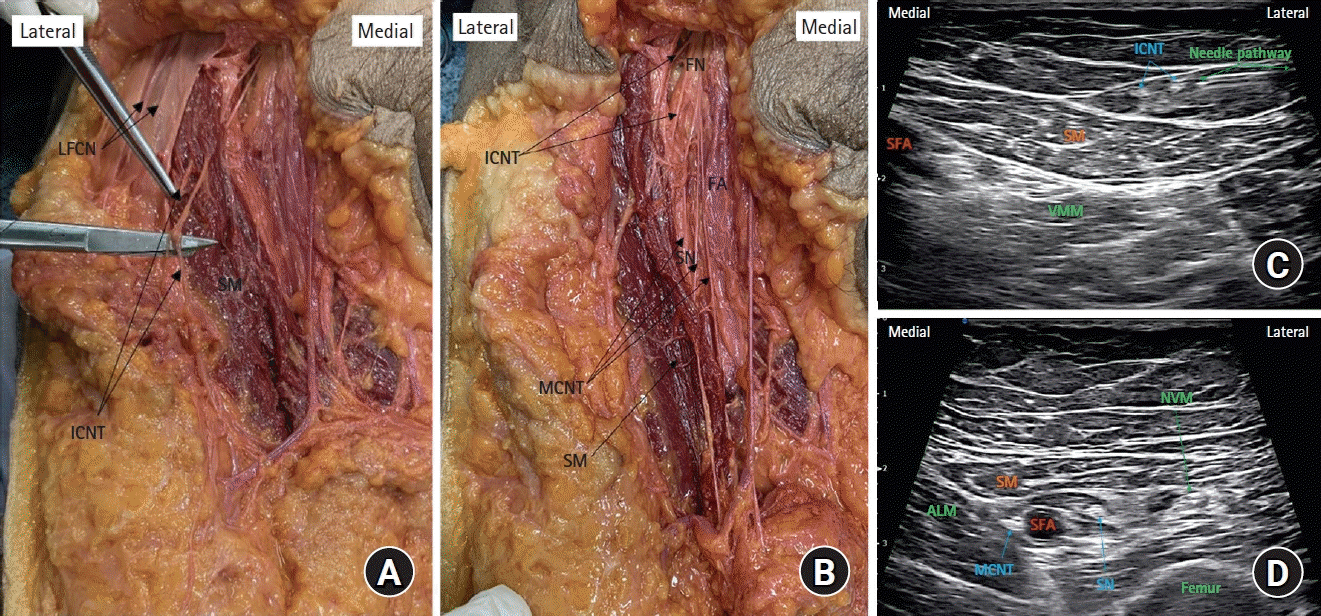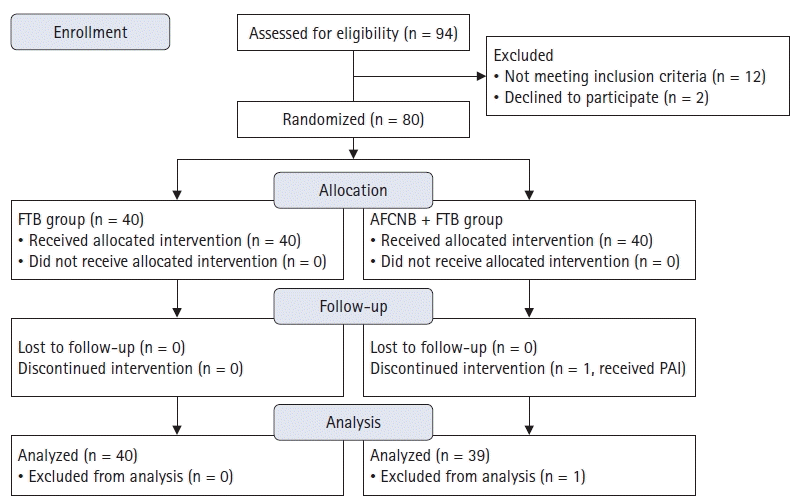1. Oseka L, Pecka S. Anesthetic management in early recovery after surgery protocols for total knee and total hip arthroplasty. AANA J. 2018; 86:32–9.
2. Ellis TA 2nd, Hammoud H, Dela Merced P, Nooli NP, Ghoddoussi F, Kong J, et al. Multimodal clinical pathway with adductor canal block decreases hospital length of stay, improves pain control, and reduces opioid consumption in total knee arthroplasty patients: a retrospective review. J Arthroplasty. 2018; 33:2440–8.
3. Li D, Ma GG. Analgesic efficacy and quadriceps strength of adductor canal block versus femoral nerve block following total knee arthroplasty. Knee Surg Sports Traumatol Arthrosc. 2016; 24:2614–9.

4. Abdallah FW, Whelan DB, Chan VW, Prasad GA, Endersby RV, Theodoropolous J, et al. Adductor canal block provides noninferior analgesia and superior quadriceps strength compared with femoral nerve block in anterior cruciate ligament reconstruction. Anesthesiology. 2016; 124:1053–64.

5. Kandarian B, Indelli PF, Sinha S, Hunter OO, Wang RR, Kim TE, et al. Implementation of the IPACK (infiltration between the popliteal artery and capsule of the knee) block into a multimodal analgesic pathway for total knee replacement. Korean J Anesthesiol. 2019; 72:238–44.

6. Kim DH, Beathe JC, Lin Y, YaDeau JT, Maalouf DB, Goytizolo E, et al. Addition of infiltration between the popliteal artery and the capsule of the posterior knee and adductor canal block to periarticular injection enhances postoperative pain control in total knee arthroplasty: a randomized controlled trial. Anesth Analg. 2019; 129:526–35.
7. Manickam B, Perlas A, Duggan E, Brull R, Chan VW, Ramlogan R. Feasibility and efficacy of ultrasound-guided block of the saphenous nerve in the adductor canal. Reg Anesth Pain Med. 2009; 34:578–80.

8. Bendtsen TF, Moriggl B, Chan V, Børglum J. Basic topography of the saphenous nerve in the femoral triangle and the adductor canal. Reg Anesth Pain Med. 2015; 40:391–2.

9. Cowlishaw P, Kotze P. Adductor canal block--or subsartorial canal block? Reg Anesth Pain Med. 2015; 40:175–6.

10. Wong WY, Bjørn S, Strid JM, Børglum J, Bendtsen TF. Defining the location of the adductor canal using ultrasound. Reg Anesth Pain Med. 2017; 42:241–5.

11. Abdallah FW, Mejia J, Prasad GA, Moga R, Chahal J, Theodoropulos J, et al. Opioid- and motor-sparing with proximal, mid-, and distal locations for adductor canal block in anterior cruciate ligament reconstruction: a randomized clinical trial. Anesthesiology. 2019; 131:619–29.
12. Bjørn S, Nielsen TD, Moriggl B, Hoermann R, Bendtsen TF. Anesthesia of the anterior femoral cutaneous nerves for total knee arthroplasty incision: randomized volunteer trial. Reg Anesth Pain Med. 2020; 45:107–16.
13. Song L, Li Y, Xu Z, Geng ZY, Wang DX. Comparison of the ultrasound-guided single-injection femoral triangle block versus adductor canal block for analgesia following total knee arthroplasty: a randomized, double-blind trial. J Anesth. 2020; 34:702–11.
14. Bendtsen TF, Moriggl B, Chan V, Børglum J. The optimal analgesic block for total knee arthroplasty. Reg Anesth Pain Med. 2016; 41:711–9.

15. Horner G, Dellon AL. Innervation of the human knee joint and implications for surgery. Clin Orthop Relat Res. 1994; (301):221–6.

16. Sogbein OA, Sondekoppam RV, Bryant D, Johnston DF, Vasarhelyi EM, MacDonald S, et al. Ultrasound-guided motor-sparing knee blocks for postoperative analgesia following total knee arthroplasty: a randomized blinded study. J Bone Joint Surg Am. 2017; 99:1274–81.
17. Johnston DF, Sondekoppam RV, Uppal V, Howard JL, Ganapathy S. Hybrid blocks for total knee arthroplasty: a technical description. Clin J Pain. 2018; 34:222–30.
18. Baccarani G, Zanotti G. The innervation of the skin on the antero-medial region of the knee. Ital J Orthop Traumatol. 1984; 10:521–5.
19. Pivec C, Bodner G, Mayer JA, Brugger PC, Paraszti I, Moser V, et al. Novel demonstration of the anterior femoral cutaneous nerves using ultrasound. Ultraschall Med. 2018; 39:318–27.

20. Riegler G, Pivec C, Jengojan S, Mayer JA, Schellen C, Trattnig S, et al. Cutaneous nerve fields of the anteromedial lower limb-Determination with selective ultrasound-guided nerve blockade. Clin Anat. 2021; 34:11–8.

21. Kampitak W, Tanavalee A, Ngarmukos S, Tantavisut S. Motor-sparing effect of iPACK (interspace between the popliteal artery and capsule of the posterior knee) block versus tibial nerve block after total knee arthroplasty: a randomized controlled trial. Reg Anesth Pain Med. 2020; 45:267–76.
22. Kertkiatkachorn W, Kampitak W, Tanavalee A, Ngarmukos S. Adductor canal block combined with iPACK (interspace between the popliteal artery and the capsule of the posterior knee) block vs periarticular injection for analgesia after total knee arthroplasty: a randomized noninferiority trial. J Arthroplasty. 2021; 36:122–9.

23. Kampitak W, Tanavalee A, Ngarmukos S, Amarase C, Songthamwat B, Boonshua A. Comparison of adductor canal block versus local infiltration analgesia on postoperative pain and functional outcome after total knee arthroplasty: a randomized controlled trial. Malays Orthop J. 2018; 12:7–14.
24. Bohannon RW. Reference values for the timed up and go test: a descriptive meta-analysis. J Geriatr Phys Ther. 2006; 29:64–8.
25. Alcazar J, Losa-Reyna J, Rodriguez-Lopez C, Alfaro-Acha A, Rodriguez-Mañas L, Ara I, et al. The sit-to-stand muscle power test: an easy, inexpensive and portable procedure to assess muscle power in older people. Exp Gerontol. 2018; 112:38–43.
26. Liu J, Colditz GA. Optimal design of longitudinal data analysis using generalized estimating equation models. Biom J. 2017; 59:315–30.

27. Mariano ER, Kim TE, Wagner MJ, Funck N, Harrison TK, Walters T, et al. A randomized comparison of proximal and distal ultrasound-guided adductor canal catheter insertion sites for knee arthroplasty. J Ultrasound Med. 2014; 33:1653–62.

28. Turner JD, Dobson SW, Henshaw DS, Edwards CJ, Weller RS, Reynolds JW, et al. Single-injection adductor canal block with multiple adjuvants provides equivalent analgesia when compared with continuous adductor canal blockade for primary total knee arthroplasty: a double-blinded, randomized, controlled, equivalency trial. J Arthroplasty. 2018; 33:3160–6.
29. Zhang LK, Zhang BY, Quan RF, Xu H, Sun YJ, Zhou JH. Single shot versus continuous technique adductor canal block for analgesia following total knee arthroplasty: a PRISMA-compliant meta-analysis. Medicine (Baltimore). 2019; 98:e15539.
30. Wang C, Chen Z, Ma X. Continuous adductor canal block is a better choice compared to single shot after primary total knee arthroplasty: a meta-analysis of randomized controlled trials. Int J Surg. 2019; 72:16–24.






 PDF
PDF Citation
Citation Print
Print



 XML Download
XML Download